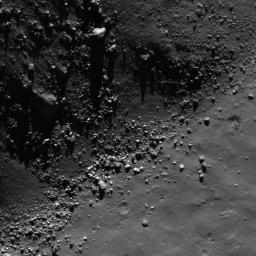
|
Central Peak of Rutherfurd
- Click the image above for a larger view
- Full-Res JPEG (1000 x 1000) (164.4 kB)
- Full-Res TIFF (1000 x 1000) (1.0 MB)
Caption:
This image from the LROC NAC shows a view of boulders, on the floor of Rutherfurd crater, about to disappear into the shadows of dusk. Image width is 510 meters.
The rubbly boulders shown above may be the remnants of impact melt that temporarily washed over a high mound on the crater floor. As the melt hardened it formed a thin, brittle shell that was later broken by quakes or small impacts.
Background Info:
NASA's Goddard Space Flight Center built and manages the mission for the Exploration Systems Mission Directorate at NASA Headquarters in Washington. The Lunar Reconnaissance Orbiter Camera was designed to acquire data for landing site certification and to conduct polar illumination studies and global mapping. Operated by Arizona State University, the LROC facility is part of the School of Earth and Space Exploration (SESE). LROC consists of a pair of narrow-angle cameras (NAC) and a single wide-angle camera (WAC). The mission is expected to return over 70 terabytes of image data.
Cataloging Keywords:
| Name | Value | Additional Values |
|---|---|---|
| Target | Moon | |
| System | Earth | |
| Target Type | Satellite | |
| Mission | Lunar Reconnaissance Orbiter (LRO) | |
| Instrument Host | Lunar Reconnaissance Orbiter | |
| Host Type | Orbiter | |
| Instrument | Lunar Reconnaissance Orbiter Camera (NAC) | |
| Detector | Narrow Angle Camera (NAC), Wide Angle Camera (WAC) | |
| Extra Keywords | Crater, Grayscale, Impact, Shadow | |
| Acquisition Date | ||
| Release Date | 2009-11-20 | |
| Date in Caption | ||
| Image Credit | NASA/GSFC/Arizona State University | |
| Source | photojournal.jpl.nasa.gov/catalog/PIA12928 | |
| Identifier | PIA12928 | |
